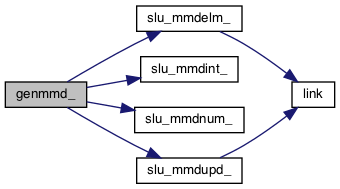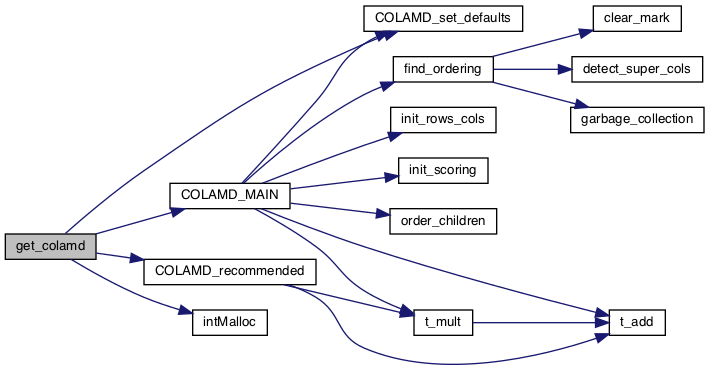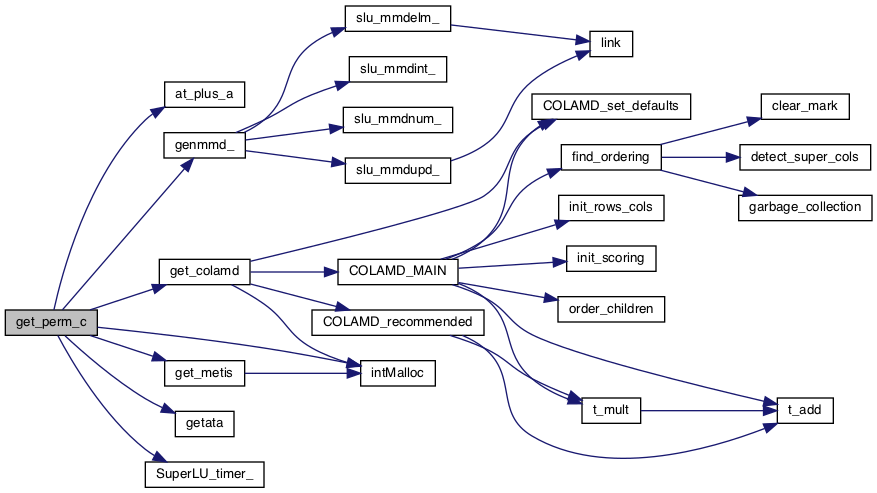Matrix permutation operations. More...
Include dependency graph for get_perm_c.c:

Functions | |
| int | genmmd_ (int *neqns, int_t *xadj, int_t *adjncy, int *invp, int *perm, int_t *delta, int_t *dhead, int_t *qsize, int_t *llist, int_t *marker, int_t *maxint, int_t *nofsub) |
| void | get_colamd (const int m, const int n, const int_t nnz, int_t *colptr, int_t *rowind, int *perm_c) |
| void | get_metis (int n, int_t bnz, int_t *b_colptr, int_t *b_rowind, int *perm_c) |
| void | getata (const int m, const int n, const int_t nz, int_t *colptr, int_t *rowind, int_t *atanz, int_t **ata_colptr, int_t **ata_rowind) |
| void | at_plus_a (const int n, const int_t nz, int_t *colptr, int_t *rowind, int_t *bnz, int_t **b_colptr, int_t **b_rowind) |
| void | get_perm_c (int ispec, SuperMatrix *A, int *perm_c) |
Detailed Description
Copyright (c) 2003, The Regents of the University of California, through Lawrence Berkeley National Laboratory (subject to receipt of any required approvals from U.S. Dept. of Energy)
All rights reserved.
The source code is distributed under BSD license, see the file License.txt at the top-level directory.
-- SuperLU routine (version 3.1) -- Univ. of California Berkeley, Xerox Palo Alto Research Center, and Lawrence Berkeley National Lab. August 1, 2008 March 25, 2023 add METIS option
Function Documentation
◆ at_plus_a()
| void at_plus_a | ( | const int | n, |
| const int_t | nz, | ||
| int_t * | colptr, | ||
| int_t * | rowind, | ||
| int_t * | bnz, | ||
| int_t ** | b_colptr, | ||
| int_t ** | b_rowind | ||
| ) |
Purpose ======= Form the structure of A'+A. A is an n-by-n matrix in column oriented format represented by (colptr, rowind). The output A'+A is in column oriented format (symmetrically, also row oriented), represented by (b_colptr, b_rowind).
◆ genmmd_()
| int genmmd_ | ( | int * | neqns, |
| int_t * | xadj, | ||
| int_t * | adjncy, | ||
| int * | invp, | ||
| int * | perm, | ||
| int_t * | delta, | ||
| int_t * | dhead, | ||
| int_t * | qsize, | ||
| int_t * | llist, | ||
| int_t * | marker, | ||
| int_t * | maxint, | ||
| int_t * | nofsub | ||
| ) |
Here is the call graph for this function:

◆ get_colamd()
| void get_colamd | ( | const int | m, |
| const int | n, | ||
| const int_t | nnz, | ||
| int_t * | colptr, | ||
| int_t * | rowind, | ||
| int * | perm_c | ||
| ) |
Here is the call graph for this function:

◆ get_metis()
Here is the call graph for this function:

◆ get_perm_c()
| void get_perm_c | ( | int | ispec, |
| SuperMatrix * | A, | ||
| int * | perm_c | ||
| ) |
Purpose
=======
GET_PERM_C obtains a permutation matrix Pc, by applying the multiple
minimum degree ordering code by Joseph Liu to matrix A'*A or A+A'.
or using approximate minimum degree column ordering by Davis et. al.
The LU factorization of A*Pc tends to have less fill than the LU
factorization of A.
Arguments
=========
ispec (input) int
Specifies the type of column ordering to reduce fill:
= 1: minimum degree on the structure of A^T * A
= 2: minimum degree on the structure of A^T + A
= 3: approximate minimum degree for unsymmetric matrices
If ispec == 0, the natural ordering (i.e., Pc = I) is returned.
A (input) SuperMatrix*
Matrix A in A*X=B, of dimension (A->nrow, A->ncol). The number
of the linear equations is A->nrow. Currently, the type of A
can be: Stype = NC; Dtype = _D; Mtype = GE. In the future,
more general A can be handled.
perm_c (output) int*
Column permutation vector of size A->ncol, which defines the
permutation matrix Pc; perm_c[i] = j means column i of A is
in position j in A*Pc.
Here is the call graph for this function:

◆ getata()
| void getata | ( | const int | m, |
| const int | n, | ||
| const int_t | nz, | ||
| int_t * | colptr, | ||
| int_t * | rowind, | ||
| int_t * | atanz, | ||
| int_t ** | ata_colptr, | ||
| int_t ** | ata_rowind | ||
| ) |
Purpose
=======
Form the structure of A'*A. A is an m-by-n matrix in column oriented
format represented by (colptr, rowind). The output A'*A is in column
oriented format (symmetrically, also row oriented), represented by
(ata_colptr, ata_rowind).
This routine is modified from GETATA routine by Tim Davis.
The complexity of this algorithm is: SUM_{i=1,m} r(i)^2,
i.e., the sum of the square of the row counts.
Questions
=========
o Do I need to withhold the *dense* rows?
o How do I know the number of nonzeros in A'*A?